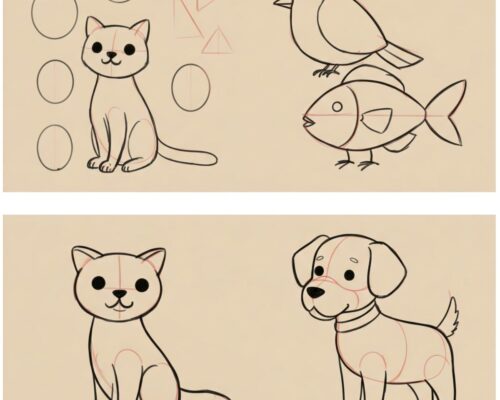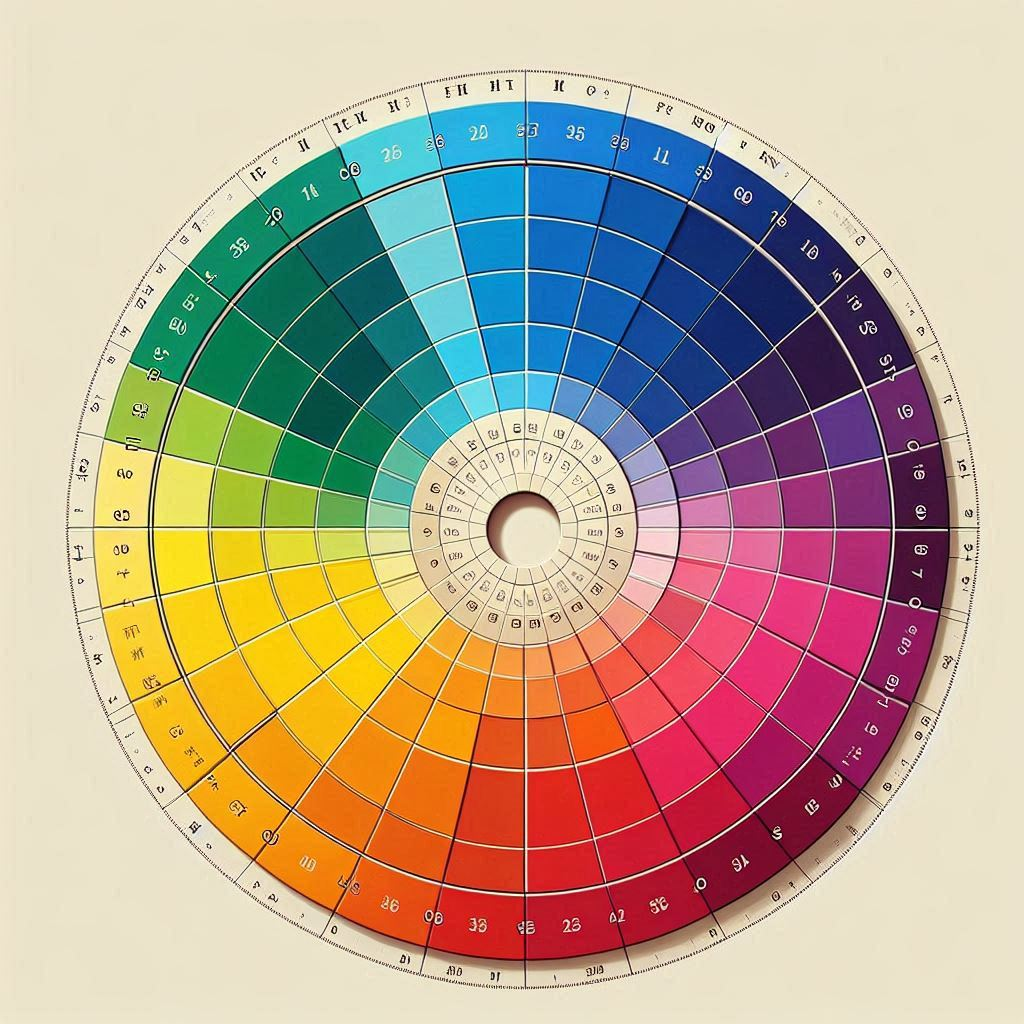Finding easy things to draw when you’re just starting out can make all the difference in your artistic journey. Whether you’re a complete beginner or someone looking to strengthen your basic skills, practicing with simple subjects helps build confidence and technique without frustration. The right drawing practice can transform your abilities surprisingly quickly, giving you the foundation for more complex art later on.
Key Points:
- Simple subjects help build essential drawing skills
- Regular practice with easy objects improves confidence
- Basic household items, geometric shapes, and nature elements make ideal starting points
- Breaking complex subjects into simple shapes is the secret to drawing anything
- Daily 15-minute practice sessions can show noticeable improvement within weeks
Why Easy Things to Draw Matter for Beginners

When you’re learning to draw, starting with complicated subjects is like trying to run before you can walk. Easy drawing subjects let you focus on fundamental skills like line quality, proportion, and basic shading without getting overwhelmed. These simple practices build your “visual vocabulary” – the mental toolkit that eventually helps you tackle more challenging subjects.
Research shows that breaking drawing practice into manageable challenges keeps motivation high and prevents discouragement. When you can successfully complete a drawing, even a simple one, your brain gets a reward that makes you want to continue practicing.
25 Easy Things to Draw for Absolute Beginners
Here’s a collection of simple drawing subjects organized by difficulty level:
Super Simple Starters (5-15 minutes each)
- Circle, square, and triangle arrangements
- A simple mug or cup
- Basic leaf shapes
- Stick figure in different poses
- Simple cartoon faces with different expressions
Beginner-Friendly Objects (10-20 minutes each)
- Apple, orange, or other simple fruit
- Basic flowers like daisies or tulips
- Books stacked together
- Your hand in a relaxed position
- Simple landscapes with horizon line and basic shapes
- Trees with simple trunk and foliage shapes
- Clouds in various formations
- A basic house with windows and door
Stepping Up Slightly (15-30 minutes each)
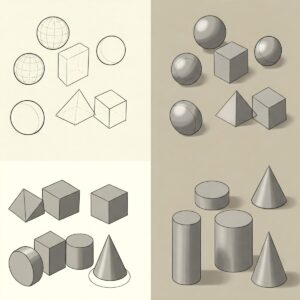
- A simple chair or stool
- Shoes or slippers
- Kitchen utensils like spoons and forks
- Simplified animal shapes like cats, dogs, or birds
- Stuffed toys
- Simple cartoon characters
- Plants in pots
- Basic food items like bread or pizza
- Simple vehicle outlines
- Everyday technology like phones or remote controls
- Simple self-portrait focusing on basic features
- Cubes and cylinders with basic shading
Drawing Practice Exercises for Beginners
Try these structured exercises to improve specific skills:
1. Contour Line Practice (15 minutes)
Draw the outline of an object without looking at your paper, focusing only on the subject. This improves hand-eye coordination and observation skills.
2. Shape Breakdown Exercise (20 minutes)
Choose a simple object and break it down into basic geometric shapes before adding details. For example, see a coffee mug as a cylinder with a curved handle attached.
3. Value Scale Exercise (10 minutes)
Create a gradient from light to dark using your pencil, practicing consistent pressure control. Apply this to simple objects to add basic shading.
4. Daily Quick Sketches (5-15 minutes)
Set a timer and draw a simple object quickly, focusing on capturing the essential elements rather than details.
“Drawing is not what one sees, but what one can make others see.”
Edgar Degas
Simple Objects to Draw for Practice
Household items make perfect drawing subjects because they’re always available and don’t move! Here’s why they’re ideal for beginners:
| Object Type | Benefits for Practice | Skills Developed |
|---|---|---|
| Mugs and Cups | Simple cylindrical shapes with handles | Proportion, ellipses, symmetry |
| Fruit | Organic forms with subtle curves | Observing light and shadow, form |
| Books | Rectangular forms with perspective | Straight lines, perspective, proportion |
| Kitchen Utensils | Interesting silhouettes with clear lines | Line quality, negative space |
| Shoes | Complex forms made of simple shapes | Shape relationships, texture |
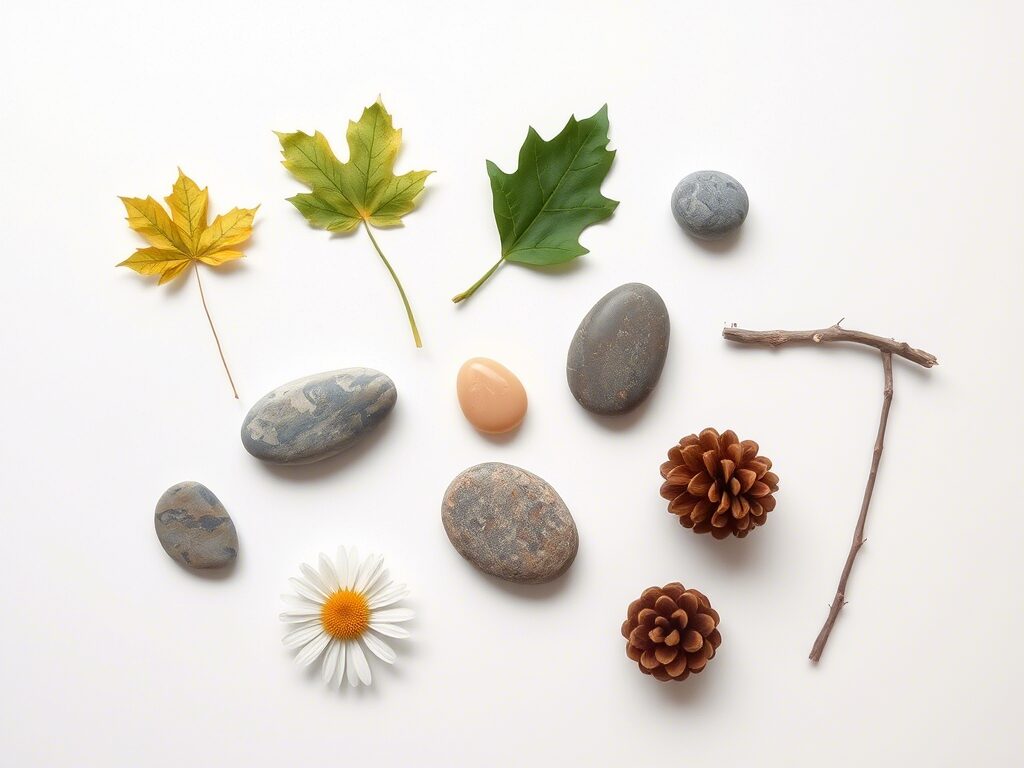
How to Improve Drawing Skills with Easy Subjects
Approaching your practice with intention makes all the difference. Here are some strategies to maximize your learning:
The 15-Minute Daily Drawing Habit
Consistency beats talent when learning to draw. Spending just 15 minutes daily with easy drawing subjects will show more improvement than occasional longer sessions. Create a simple routine where you draw one easy object each day, focusing on improving one specific aspect each time.
For inspiration, check out these painting techniques on ProminentPainting.com that can also enhance your drawing skills.
Step-by-Step Approach to Drawing Anything
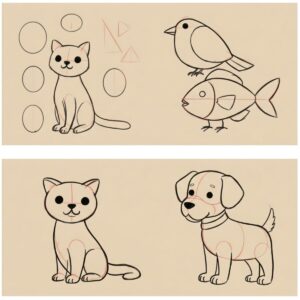
- Observe thoroughly before putting pencil to paper
- Identify basic shapes that make up the object
- Sketch these shapes lightly as a foundation
- Refine the outlines to more accurately represent the object
- Add details only after the structure is correct
- Consider light source and add simple shading
- Review and adjust proportions and relationships
Drawing Ideas for When You’re Bored
Boredom can actually be a great opportunity for drawing practice! Keep these ideas handy for when you need quick inspiration:
- Draw objects from your desk or table
- Sketch simple versions of your favorite cartoon characters
- Practice basic face features (eyes, noses, mouths)
- Draw simplified versions of animals from memory
- Create patterns using only basic shapes
- Draw ordinary objects like keys, scissors, or paperclips
- Sketch simple landscapes from imagination
If you’re interested in eventually moving to painting, check out watercolor basics for beginners to see how drawing skills transfer to painting.
Easy Drawing Subjects to Build Confidence
Building confidence is crucial when learning to draw. Choose subjects that let you experience success while still challenging you slightly:
- Start with geometric objects – perfect for understanding form
- Move to symmetrical items – help train your eye for balance
- Try simple food items – stationary and familiar shapes
- Practice basic flowers – introduce organic forms
- Attempt cartoon-style animals – simplify complex subjects
Tools for Beginner Drawing Practice
You don’t need fancy supplies to start drawing. Basic materials work perfectly for practice:
- Pencils: HB and 2B pencils are versatile for beginners
- Paper: Regular printer paper works fine for practice
- Eraser: A simple white eraser is gentle on paper
- Sharpener: Keep pencils sharp for precision
- References: Simple objects or printed reference photos
For more on art supplies, check out this essential guide to painting supplies which includes many tools that work for drawing too.
Common Challenges When Learning to Draw
Everyone faces obstacles when learning to draw. Here are some common challenges and how to overcome them:
Perfectionism
Solution: Focus on progress, not perfection. Date your practice drawings to see improvement over time.
Inconsistent Proportions
Solution: Use the “measuring technique” – holding your pencil at arm’s length to compare sizes.
Difficulty Seeing Shapes
Solution: Try turning reference photos upside down to see shapes rather than objects.
Getting Discouraged
Solution: Join online communities like DeviantArt where beginners support each other.
Drawing expert Betty Edwards explains in her book “Drawing on the Right Side of the Brain” that learning to draw is largely about learning to see differently – a skill anyone can develop with practice.
Tracking Your Progress with Easy Drawing Exercises
Drawing Progression Timeline
See how practice leads to improvement over time
Day 1: First Attempt
The first drawing shows basic shape recognition but has uneven proportions and hesitant lines. This is normal! Everyone starts here.
- Focus is on capturing the general outline
- Proportions aren’t quite right
- Lines may be sketchy or uncertain
Week 2: Early Improvements
After just two weeks of daily practice, notice how the proportions are more accurate and the lines show increased confidence.
- More accurate overall shape
- Better proportions and symmetry
- More confident, deliberate lines
- Beginning attempts at basic shading
Month 1: Adding Techniques
One month in, the drawing now includes basic shading techniques and shows a better understanding of form and volume.
- More accurate contours and details
- Introduction of light and shadow
- Basic shading techniques applied
- Beginning to show dimension and form
Month 3: Refined Skills
After three months of consistent practice, the drawing shows significant refinement with advanced shading, texture, and attention to details.
- Accurate representation with refined details
- Sophisticated shading showing volume
- Texture details (like skin texture and highlights)
- Understanding of light source and reflection
- Confident technique and personal style emerging
Seeing your improvement is motivating! Create a simple system to track your growth:
- Date all practice drawings
- Try drawing the same simple object once a month
- Take photos of your drawings to create a digital portfolio
- Note which easy things to draw felt challenging and which felt comfortable
- Set specific mini-goals for each practice session
Conclusion: Finding Joy in Simple Drawing Practice
Starting with easy things to draw is the smartest way to build skills that last. Remember that every master artist once began with simple lines and basic shapes. By practicing regularly with accessible subjects, you’ll develop the foundation for more complex art while enjoying the process. Be patient with yourself, celebrate small victories, and most importantly, find pleasure in the act of drawing itself. Keep a collection of these easy things to draw handy, and you’ll never be without inspiration for your next practice session.
FAQ: Easy Things to Draw for Practice
How long does it take to get good at drawing?
Noticeable improvement can happen within 2-3 weeks of daily practice. However, developing strong drawing skills typically takes 6-12 months of consistent practice. Remember that progress isn’t linear – you’ll experience both breakthroughs and plateaus.
What are some simple drawing exercises to improve hand control?
Try drawing perfectly straight lines freehand, smooth circles in one motion, and continuous spiral patterns. Also practice hatching (parallel lines) with consistent spacing. These exercises improve hand steadiness and coordination.
What are the basic drawing techniques for beginners?
Essential techniques include contour drawing (outlining), gesture drawing (capturing movement), hatching and cross-hatching (for shading), blending (for smooth transitions), and basic perspective. Master these fundamentals before moving to more advanced techniques.
How can I draw faces for beginners?
Start with a simple oval for the head, then add a horizontal line for eyes (halfway down) and a vertical line for nose/mouth alignment. Practice individual features separately before combining them. Follow the basic proportions: eyes in the middle of the head, nose halfway between eyes and chin, mouth halfway between nose and chin.
What simple landscape drawing ideas work for beginners?
Start with a basic horizon line, then add simple shapes for mountains, trees, or buildings. Practice clouds as simple curved shapes, and trees as combinations of cylindrical trunks and circular foliage. Begin with black and white before attempting color.

